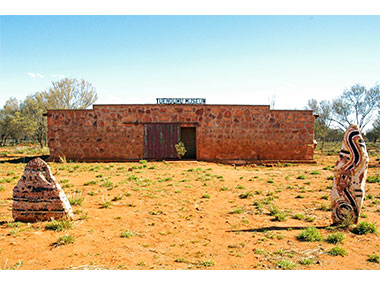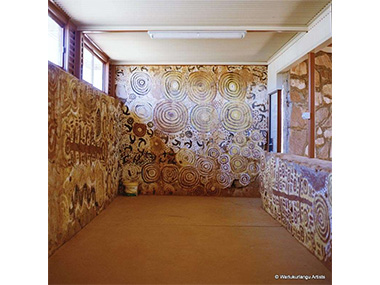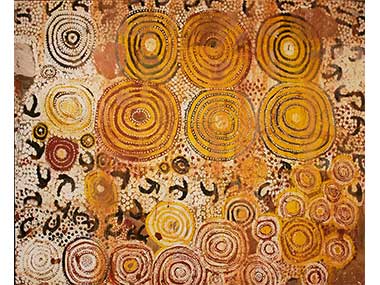HISTORY TO BE MADE THIS WEEKEND

How the Yuendumu Men's Museum used to look.
Posted by Jeremy Eccles | 04.09.15
With the annual Desert Mob show and fair happening this weekend in Alice Springs, many will also be dashing up the Tanami Track to Yuendumu on Sunday to be present at the historic re-opening of the Yuendumu Men's Museum – closed since the late 70s – the place that brought ceremonial art in from the deserts to the new settlements where tribal people were being encouraged to live a year before similar events occurred in Papunya.
This is what I wrote when the story first broke in 2007 in the Aboriginal Studies Journal:
The foundation myth is simple: Aboriginal art as we know it today – acrylic painting on canvas - emerged from Papunya in 1971/2. But now the question is being asked - was the less well-known Yuendumu community actually the progenitor of the contemporary Aboriginal painting movement? This fascinating theory has it that it was at this Warlpiri township, 150kms up the Tanami Track from Papunya, settled in the 60s, that the initial decision was made to give ceremonial art a permanent form.
Ironically, it took the form of painting on the walls of a museum that the male elders had built; but, unlike the iconic Papunya School wall paintings that we know so much about, it's still there.
It's even possible that school-teacher Geoffrey Bardon witnessed the opening of the Yuendumu Museum on 31 July 1971; and it's certain that Paddy Japaljarri Stewart – one of the artists who tackled the Yuendumu school doors in the 1980s - was painting in both Yuendumu in the late 60s and at the Papunya school a year or so later.
So perhaps Papunya wasn't the tabula rasa we've always been lead by Bardon to believe it was?
Although Papunya painting quickly mutated from a project mainly intended to impress and educate the young of the many tribes brought in to Papunya with the existence and complexity of their culture, the purity of the Yuendumu men's intentions to bring the essence and artefacts of their religion in from Desert caves and distant sacred sites to their new, Western-planned community remained paramount for a decade.
Indeed, it may be hypothesised that the failure of this project – the Museum ceased to function as a ceremonial site and a tourist attraction late in the 70s – may have lead on to the commercialisation of art in Yuendumu in the 80s.
According to Paddy Japaljarri Stewart and Paddy Japaljarri Sims, it all began with a Jungarrayi sand-painting out bush, intended as a challenge to other skin groups (of which there are 8 in all in the Desert) to do something about the threat to their culture when they no longer lived on the lands they had a responsibility for. The Japaljarris and Jangalas took up the challenge – and in the end all the skin group leaders came together to build a substantial museum and fill it with their most sacred objects. The SA Museum supplied both lockable shelving for the most secret/sacred objects and glass cases for viewable items. Part of the floor area was a group sand painting like the one created in the Art Gallery of NSW at a Perspecta in the 80s.
But what to do with the walls? Paint them – nine works in all, two more than 15 metres long and one, more than 2 metres high. And such images as I've seen suggest a much richer iconography was incorporated in the privacy of the Museum (no women or children admitted) than was possible outdoors on the Papunya school walls. The painters were Barney Japanagka Poulsen, Jimmy Jupurrula Peters, Larry Jakamarra Nelson, Rufus Jungarrayi Woods, Comadi Japanangka Martin, Pompy Japanangka Martin and Darby Jampijinpa Ross, who died only a few years ago at 100.
Sadly, the Museum – which had been opened with such a flourish of dignitaries from the NT and SA - fell into disrepair in the late 70s, though in a sense it was succeeded by the Warlukurlangu Art Centre in the 80s. In that Centre's early years, it was one of the most serious about attaching story to every painting that was sold. What happened to the precious tjuringa locked away, however, seems to be a mystery.
But in about 2005, there was the realisation that something precious was on the brink of oblivion. A Men's Museum Committee was formed, funds were raised and restoration was commenced. In 2011, the process of detailing the iconography of the art began.
Will a revived Yuendumu Museum come to be seen as the stable that gave birth to "the last great art movement of the 20th Century" (Robert Hughes) – or will the oh-so-well documented legend of Papunya survive?
Now, Warlukurlangu Artists is celebrating its 30th birthday as part of this weekend's event, and there was hope that the SA Museum's Philip Jones would be launching his book on the Men's Museum, 'A Desert Revelation'. It is delayed, but, like the Museum re-opening - it will come in the fullness of time.
URL: http://warlu.com/about/special-projects/mens-museum/
Share this:
»  del.icio.us
»
del.icio.us
»  Digg it
»
Digg it
»  reddit
»
reddit
»  Google
»
Google
»  StumbleUpon
»
StumbleUpon
»  Technorati
»
Technorati
»  Facebook
Facebook
Contact Details

The glorious interior of the Men's Museum.

Part of the 'Emu Dreaming' mural created in the early 70s by Darby Ross and collaborators.
Further Research
Artists: Barney Japanagka Poulsen | Comadi Japanangka Martin | Darby Jampijinpa Ross | Jimmy Jupurrula Peters | Larry Jakamarra Nelson | Paddy Japaljarri Sims | Paddy Japaljarri Stewart | Pompy Japanangka Martin | Rufus Jungarrayi Woods
News Tags: Aboriginal Studies Journal | Geoffrey Bardon | Jeremy Eccles | Papunya | SA Museum | Warlukurlangu | Yuendumu Men's Museum
News Categories: Australia | Blog | Event | Exhibition | Feature | Industry | News | Reception
Exhibition Archive
- 10.10.17 | TARNANTHI 2017
- 11.08.17 | Natsiaas 2017
- 20.07.17 | APY ART DOMINATES THE WYNNE
- 17.07.17 | Anangu Artist Wins $100,000 Prize
- 14.07.17 | The End of AAMU
- 11.07.17 | ART ACROSS THE COUNTRY
- 11.07.17 | TARNANTHI IN OCTOBER
- 05.07.17 | TJUNGUṈUTJA - from having come together
- 13.06.17 | Ghost-Nets Straddle the World
- 07.06.17 | Grayson Perry Going Indigenous?
- 05.06.17 | Barks Bigger than Ben Hur
- 27.05.17 | NGA QUINQUENNIAL 2017
- 21.05.17 | Blak Douglas Finds Home at the NGA
- 21.05.17 | BRIAN ROBINSON WINS HAZELHURST WOP
- 18.05.17 | PARRTJIMA 2.0
Advertising

